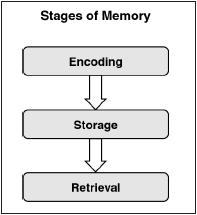Encoding- getting information into your brain

Encoding is the process whose purpose is to assign a meaning to the information to be memorized. How effectively you can retrieve information depends on how deeply you have encoded it, and how well you have organized it in your memory. The process of encoding refers not only to the information being memorized, but also to its environmental, cognitive, and emotional context. Also, using mnemonic devices to associate ideas and images helps us to create links that aid in encoding. But even when information has been well encoded, there is still possibility that it can be forgotten. (selective memory, brain damage, diseases)
There are different types of encoding, visual (pictures and images), Acoustic (sound, words), and semantic encoding or the encoding of meaning (words, phrases,etc.). During Encoding we group together information which we take for granted. We more easily recall information when we organize it into meaningful units and groups. These groupings created during the encoding process are composed of a few broad concepts divided and subdivided into narrower concepts and facts. Just as when studying,the groups are easier to remember because of the organization than if they were to be randomly presented. (see below) After encoding the information, it is then stored in terms of sensory, short term (working), or long term (infinite capacity) memory.
There are different types of encoding, visual (pictures and images), Acoustic (sound, words), and semantic encoding or the encoding of meaning (words, phrases,etc.). During Encoding we group together information which we take for granted. We more easily recall information when we organize it into meaningful units and groups. These groupings created during the encoding process are composed of a few broad concepts divided and subdivided into narrower concepts and facts. Just as when studying,the groups are easier to remember because of the organization than if they were to be randomly presented. (see below) After encoding the information, it is then stored in terms of sensory, short term (working), or long term (infinite capacity) memory.
Storage- retaining and keeping information

Sensory Memory is divided into two categories, Iconic memory which is that we have a quick photographic memory for a few moments. The other catergory, the echoic memory which is sensory memory for auditory stimuli which lingers 3 or 4 seconds. The Iconic memory is a momentary sensory memory of visual stimuli; a photographic or picture-image memory lasting no more than a few tenths of a second. For an instant, our eyes register an exact representation of a scene and we can recall any part of it with great detail but only for a few tenths of a second. If you tried recalling it a few seconds after, only a little of the photographic memory would remain since the visual screen clears it quickly as it must in order for new images to be imposed over old ones. (we look at new images constantly) The echoic memory is a momentary sensory memory of sounds and hearing; if attention is elsewhere, sounds and words can still be recalled within 3 or 4 seconds. For example, if you are having a conversation with someone and your attention diverts towards a TV and the person asks for you to repeat what they just said, you will only recall the last few words from your mind's storage or echo chamber. (zoning out in class or daydreaming)
Retrieval- recalling stored information

Memory retrieval consists of three different aspects: recall, recognition, and relearning. To most people, memory is equal with recall, the ability to retrieve information not in conscious awareness. It is a part memory in which the person must retrieve information learned earlier, as on a fill-in-the-blank test in school. Recognition is the part memory in which the person needs to only identify items previously learned, as on a multiple choice test. Relearning is a part memory that assesses the amount of time saved when learning material for a second time.
Retrieval cues are bits of related information we group together while processing a certain amount of information to be remembered. These groups are linked in some way to the context of that certain piece of information, and they become a part of a web of stored associations and larger groupings. When one of these associated bits catch our attention, we retrieve the target information conciously. This process of activating associations which is often unconsciously is called priming. The context in which we originally experienced an event or grouped a thought can flood our memories with retrieval cues, leading us to the target memory. If we are in a different context quite similar to the original one, we may experience deja vu as many of these cues return and trick us into unconsciously retrieving the target memory. click here to learn about deja vu
Retrieval cues are bits of related information we group together while processing a certain amount of information to be remembered. These groups are linked in some way to the context of that certain piece of information, and they become a part of a web of stored associations and larger groupings. When one of these associated bits catch our attention, we retrieve the target information conciously. This process of activating associations which is often unconsciously is called priming. The context in which we originally experienced an event or grouped a thought can flood our memories with retrieval cues, leading us to the target memory. If we are in a different context quite similar to the original one, we may experience deja vu as many of these cues return and trick us into unconsciously retrieving the target memory. click here to learn about deja vu
How to remember better!

The psychology of memory suggests concrete strategies for improving memory. These include scheduling spaced study times, actively rehearsing information to be learned, aiding encoding by making well organizd, vivid, and personally meaningful associations, using mnemonic techniques, returning to contexts and moods that are full of associations, recording memories before misinformation can corrupt them, minimizing interference, and self-testing to rehearse information and find gaps in your memory.
Mnemonic devices, used in the USA world memory Championships. (See interview with Joshua Foer, Sports, and Math for more information). In using Mnemonic devices, the hippocampus keeps strengthening the associations among these new elements until, it no longer needs to do so. The cortex will have learned to associate these various properties itself to reconstruct what we call a memory.
Mnemonic devices, used in the USA world memory Championships. (See interview with Joshua Foer, Sports, and Math for more information). In using Mnemonic devices, the hippocampus keeps strengthening the associations among these new elements until, it no longer needs to do so. The cortex will have learned to associate these various properties itself to reconstruct what we call a memory.
